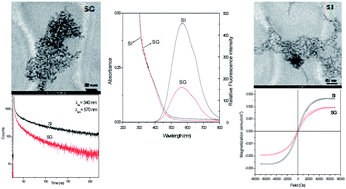This paper describes the synthesis, optical, photophysical and magnetic behavior of GMP-templated binary (β-Fe2O3/CdS) (SG) and ternary (β-Fe2O3/Ag/CdS) (SI) nanohybrids. In these systems the amount of different phases (GMP, β-Fe2O3 and Ag) and pH have been optimized so as to achieve the maximum emission. Analysis of the morphology of these nanohybrids by AFM, FE-SEM and TEM measurements shows that fresh samples of binary and ternary nanohybrids contain spherical nanoparticles, which are transformed into nanorods and nanowires, respectively upon aging. Both SAED and XRD analysis of the nanohybrids show them to contain CdS and Ag phases with hexagonal and β-Fe2O3 phase with orthorhombic structures, respectively. The excitation of binary nanohybrids by 340 nm light results in the quenching of the emission of the CdS phase with a bimolecular quenching rate constant of 2.1 × 1010 dm3 mol−1s−1. On the other hand, excitation of CdS using the same wavelength of light in the ternary nanohybrid results in enhancement of fluorescence intensity by a factor of ∼3 associated with a red-shift in the emission maximum compared to the binary nanohybrid. The increase in the intensity of emission of SI is also evidenced by an increase in average lifetime value of the ternary complex (52 ns) compared to that of the binary complex (30 ns). An examination of fluorescence anisotropy in both the cases shows an increase in the value of anisotropy and rotational correlation time (θ2) upon aging. The presence of CdS in the binary hybrid results in the reduction of saturation magentization value (0.0019 emu cm−2) by an order of magnitude as compared to β-Fe2O3 (0.019 emu cm−2) and a change in the magnetic behavior from superparamagnetic to ferromagnetic with coercivity and remanance values of 1200 Oe and 7.9 × 10−5 emu cm−2, respectively. A similar change in magnetic behavior is observed in the case of SI, which are, however, associated with relatively higher values of Ms (0.0026 emu cm−2), Hc (1273 Oe) and Mr (1.78 × 10−4 emu cm−2), compared to those of the binary hybrid, respectively. The presence of Ag in the ternary hybrid thus induces a change in optical, photophysical and magnetic properties, which are correlated with a change in their morphology.


 Please wait while we load your content...
Please wait while we load your content...